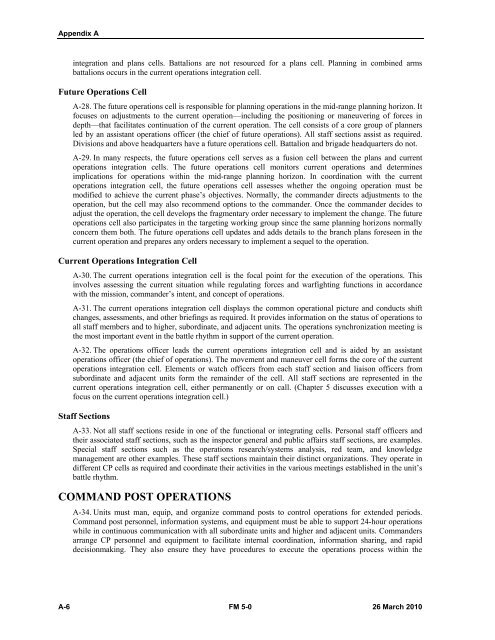FM 5-0, The Operations Process - Federation of American Scientists
FM 5-0, The Operations Process - Federation of American Scientists
FM 5-0, The Operations Process - Federation of American Scientists
You also want an ePaper? Increase the reach of your titles
YUMPU automatically turns print PDFs into web optimized ePapers that Google loves.
Appendix A<br />
integration and plans cells. Battalions are not resourced for a plans cell. Planning in combined arms<br />
battalions occurs in the current operations integration cell.<br />
Future <strong>Operations</strong> Cell<br />
A-28. <strong>The</strong> future operations cell is responsible for planning operations in the mid-range planning horizon. It<br />
focuses on adjustments to the current operation—including the positioning or maneuvering <strong>of</strong> forces in<br />
depth—that facilitates continuation <strong>of</strong> the current operation. <strong>The</strong> cell consists <strong>of</strong> a core group <strong>of</strong> planners<br />
led by an assistant operations <strong>of</strong>ficer (the chief <strong>of</strong> future operations). All staff sections assist as required.<br />
Divisions and above headquarters have a future operations cell. Battalion and brigade headquarters do not.<br />
A-29. In many respects, the future operations cell serves as a fusion cell between the plans and current<br />
operations integration cells. <strong>The</strong> future operations cell monitors current operations and determines<br />
implications for operations within the mid-range planning horizon. In coordination with the current<br />
operations integration cell, the future operations cell assesses whether the ongoing operation must be<br />
modified to achieve the current phase’s objectives. Normally, the commander directs adjustments to the<br />
operation, but the cell may also recommend options to the commander. Once the commander decides to<br />
adjust the operation, the cell develops the fragmentary order necessary to implement the change. <strong>The</strong> future<br />
operations cell also participates in the targeting working group since the same planning horizons normally<br />
concern them both. <strong>The</strong> future operations cell updates and adds details to the branch plans foreseen in the<br />
current operation and prepares any orders necessary to implement a sequel to the operation.<br />
Current <strong>Operations</strong> Integration Cell<br />
A-30. <strong>The</strong> current operations integration cell is the focal point for the execution <strong>of</strong> the operations. This<br />
involves assessing the current situation while regulating forces and warfighting functions in accordance<br />
with the mission, commander’s intent, and concept <strong>of</strong> operations.<br />
A-31. <strong>The</strong> current operations integration cell displays the common operational picture and conducts shift<br />
changes, assessments, and other briefings as required. It provides information on the status <strong>of</strong> operations to<br />
all staff members and to higher, subordinate, and adjacent units. <strong>The</strong> operations synchronization meeting is<br />
the most important event in the battle rhythm in support <strong>of</strong> the current operation.<br />
A-32. <strong>The</strong> operations <strong>of</strong>ficer leads the current operations integration cell and is aided by an assistant<br />
operations <strong>of</strong>ficer (the chief <strong>of</strong> operations). <strong>The</strong> movement and maneuver cell forms the core <strong>of</strong> the current<br />
operations integration cell. Elements or watch <strong>of</strong>ficers from each staff section and liaison <strong>of</strong>ficers from<br />
subordinate and adjacent units form the remainder <strong>of</strong> the cell. All staff sections are represented in the<br />
current operations integration cell, either permanently or on call. (Chapter 5 discusses execution with a<br />
focus on the current operations integration cell.)<br />
Staff Sections<br />
A-33. Not all staff sections reside in one <strong>of</strong> the functional or integrating cells. Personal staff <strong>of</strong>ficers and<br />
their associated staff sections, such as the inspector general and public affairs staff sections, are examples.<br />
Special staff sections such as the operations research/systems analysis, red team, and knowledge<br />
management are other examples. <strong>The</strong>se staff sections maintain their distinct organizations. <strong>The</strong>y operate in<br />
different CP cells as required and coordinate their activities in the various meetings established in the unit’s<br />
battle rhythm.<br />
COMMAND POST OPERATIONS<br />
A-34. Units must man, equip, and organize command posts to control operations for extended periods.<br />
Command post personnel, information systems, and equipment must be able to support 24-hour operations<br />
while in continuous communication with all subordinate units and higher and adjacent units. Commanders<br />
arrange CP personnel and equipment to facilitate internal coordination, information sharing, and rapid<br />
decisionmaking. <strong>The</strong>y also ensure they have procedures to execute the operations process within the<br />
A-6 <strong>FM</strong> 5-0 26 March 2010















